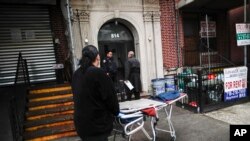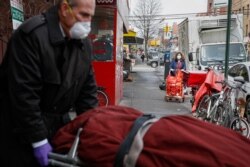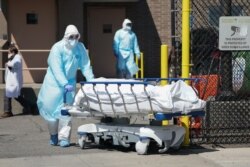As the White House warns Americans to brace for one of the worst weeks of deaths in the nation’s history, funeral directors and cemeteries are preparing for the wave of coronavirus dead.
In New York State, where nearly half the U.S. deaths have occurred, the city’s four crematoriums are already working around the clock and are booked until the middle of April.
“We have no more stretchers to hold bodies,” one overwhelmed funeral director in the borough of Brooklyn who did not want her name used told VOA. Their refrigerators are also at capacity.
She said their family-run funeral business normally sees four to six funerals a week, but since late January the numbers began to quickly double, and they are currently trying to handle at least 20 funerals a week.
“I am from a line of funeral directors,” she said. “It is not natural for me to say ‘no’.” But she admits at some point soon she will have to start turning families away.
As the state’s doctors, nurses and healthcare workers form the frontlines of saving those infected with the virus, funeral directors and cemetery workers have become a second front in tending to pandemic casualties.
At Green-Wood Cemetery, one of the city’s most picturesque and historic burial grounds, President and CEO Richard Moylan is trying to balance serving the public while keeping his own staff healthy.
“I will be happy if we can keep getting our masks and our gloves,” Moylan said of the personal protective equipment needed to prevent contracting COVID-19, the disease caused by the coronavirus.
Moylan has sent as many of his staff as possible home to work, keeping only a core group of essential office workers, custodians and gravediggers on site. He has tried to keep them healthy by separating them into two teams, so that if one group has a sick member, the other team will not have been exposed to that person and will be able to continue operations.
“The whole situation has been really difficult,” he said.
Mike Lanotte, Executive Director of the New York State Funeral Directors Association, said his organization began working last month to start procuring larger volumes of protective equipment for funeral directors as well as other supplies.
“We did the best we could, but it was coming so fast,” Lanotte told VOA. “As much as we wanted to be proactive, some of it we are trying to react to as quickly as possible.”
Funeral directors can be exposed to the virus when they collect bodies from hospitals and nursing homes, as well as when they engage with families who are burying their loved ones. Some have also expressed concern about potential exposure during the embalming process.
Large funerals have ended as rules are enforced about limiting gatherings and social distancing. Moylan said he watched a service outside his window at Green-Wood cemetery that saw just a handful of mourners spaced far apart. Others remained in their cars. No flowers were placed at the grave.
New York has 1,700 funeral homes and 3,700 licensed funeral directors.
Before the pandemic, the state averaged about 425 deaths each day. On Tuesday, there were 731 deaths just from confirmed coronavirus cases.
But it is not clear that every coronavirus death is being recorded. Many victims are dying at home, not in hospitals. People are discouraged from being tested unless they require hospitalization, and there is very little posthumous virus testing.
New York Mayor Bill de Blasio said Tuesday that he is assuming the “vast majority” of at home deaths are COVID-19 related.
“That makes it even more sober, the sense of how many people we are losing, how many families are suffering, how real this crisis is,” he said.
De Blasio said the city has the capacity it needs for the surge in deaths and is receiving assistance from the U.S. military and the federal government.
But the funeral director in Brooklyn said she and other colleagues have been contacted by the medical examiner’s office to help collect and store bodies.
“The medical examiner actually asked us if they could send bodies directly to us for cremation,” Moylan of Green-Wood Cemetery said. “We had to turn them down because we cannot store them right now.”
Last week, the state lifted restrictions on crematoriums, allowing them to work virtually around the clock.
As funeral homes started reaching capacity last week, the State Funeral Directors Association put out a distress call to colleagues in other states.
“Before we even made the request, the funeral directors from around country through our national association, were already answering the bell before it even rang and volunteering their time and services to come into New York to help,” Lanotte said.
While it is not clear how soon this health crisis will pass, the state’s funeral directors say their work is a vocation and they will continue to be there to support grieving families in their time of need.








